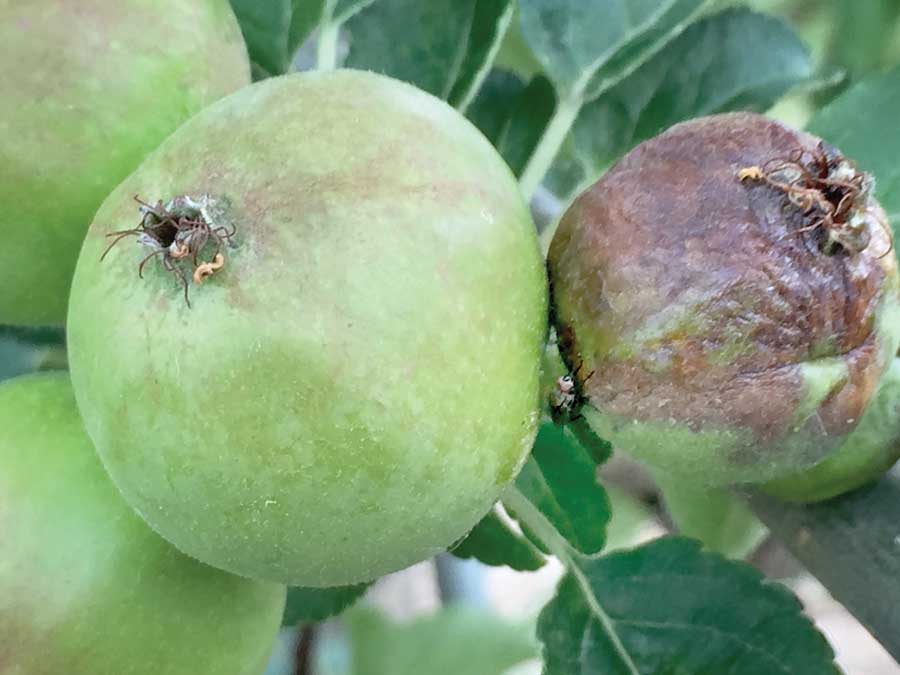
Matt Boucher hand collects bees from blossoms in an orchard infested with fire blight. Boucher is capturing bees and other insects in an effort to find if they are transmitting fire blight bacteria. (Courtesy Heather Grab/Cornell University)
Matt Boucher, a doctoral student at Cornell University, thinks insect transmission is one way fruit trees contract fire blight.
So, he’s working to identify which bugs are responsible and, ultimately, to develop preventive management strategies to disrupt the process.
His work is a continuation of research started in the early 1900s, then unaccountably abandoned in the 1930s, prior to World War II. Early researchers believed insects had a passive role in fire blight transmission.
They posited a process of disease spread from infected to healthy surfaces by means of bug movement from one to the other.
It’s not a long reach, considering the ease with which bees track viral and bacterial disease into their hives. They do so by picking up infected pollen and bringing it home.
However, Boucher said, some research suggests insects might play a more active role: carrying the bacteria inside their guts, incubating it for a period of time, before carrying it to and infecting new hosts, such as fruit trees.
Understanding the pathogen
Boucher’s interest stemmed from a conversation with George Sundin, a Michigan State University plant pathologist, about the possible interaction of pathogens in insect guts and hosts.
The discussion centered on novel type III secretion systems (T3SS), which are hollow needlelike structures that bacteria use to transmit disease-causing proteins into hosts.
Plant pathogens can have multiple T3SSes, and they can be active at different times during the disease cycle, Boucher said. For example, one may be active during plant infection, while others are active during insect vectoring.
Fire blight bacteria have three T3SSes. Sundin’s group successfully knocked out the one responsible for plant infection, and no fire blight symptoms appeared on fruit.
They have hypothesized that the remaining two are active in the insect when it transmits the disease.
So why not just use genetic engineering to disrupt T3SS function, much like an Ohio State University horticulture research group did a few years ago?
There are two reasons, said Boucher. First, the chances of the federal government allowing an altered bacteria to be released into the environment are very low. Secondly, an altered bacteria is a weakened bacteria and would not survive competition in a world populated by unaltered bacteria.
So Boucher is working to identify which insects are transmitting fire blight and, in addition, to determine if the T3SSes are active once the insect is infected. “Do they allow the pathogen to persist in the insect’s gut for a longer time? Do they change the insects’ behaviors?” he said
Which bug?

The fly sitting on the apple on the right (seen between the two apples) may be there for the sugar produced by the fire blight bacteria. Based on his observations of flies on cankered fruit, Boucher wonders if they’re a vector for the disease.(Courtesy Heather Grab/Cornell University)
Boucher will be capturing insects from yellow sticky cards in a fire blight-infected orchard through September for his research. Each tree has two cards, one in the canopy and the other down on the trunk at knee level.
Boucher places the cards on 20 trees, collecting a total of 40 cards each week. Then he takes the cards back to the lab, removes the bugs and grinds them up. “We run DNA tests to see if they are carrying the pathogen,” he said.
He’s also catching bees on flowers using collection vials. Can fire blight persist in hives? The answer is no. “But we have no information about what’s inside their guts,” he said.
Anecdotal suspects
Early in his research, Boucher implicated potato leafhopper as a fire blight vector but has not yet confirmed it. Already, he has collected 400 potato leafhopper samples, with more expected throughout the season.
Leafhoppers are of interest because of their eating style. They are a piercing-sucking insect that uses a stylet to puncture plants and probe around for nutrients within the phloem and the xylem.
They leave a telltale of their passing: toxic saliva associated with something called hopperburn, a browning around the edge of the leaves caused by the insects’ siphoning. “It is also caused by the plant’s physiological response to hopper feeding,” he said.
He also has a number of other suspects for which he has no proof, but based on personal observations they represent possibilities.
Bees have been implicated in past research, and Boucher captured 500 bees during bloom. The majority were honeybees along with one native bee species. Flies and aphids are other possibilities.
The ooze that comes out of cankers on a fire blight-infected tree is a mixture of plant sap, fire blight bacteria and a sugar produced by the bacteria. Boucher thinks the sugar may be an attractant to flies.
In June, when ooze comes out of the fruitlets, Boucher has seen flies land and remain on the ooze for up to a minute. “When flies land on the margins of the canker’s ooze, they could be picking up bacteria for possible transmission,” he said.
He’s caught “lots” of flies on the yellow cards, adding credence to his belief they may be involved, but he hasn’t identified the specific culprit yet.
Aphids excrete honeydew, which may contain fire blight, and ants eat the honeydew because it is nutrient-rich. “If the ants carry infected honeydew away, they could inadvertently transport the pathogen along with it,” Boucher said.
That said, he thinks this is a less likely scenario, compared to either bee or hopper transmission. But as long as aphids continue to appear on the sticky cards, he’ll be testing aphids to see if they are involved. •
– by Dave Weinstock






Leave A Comment